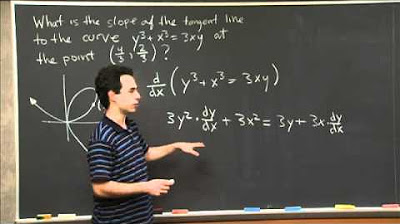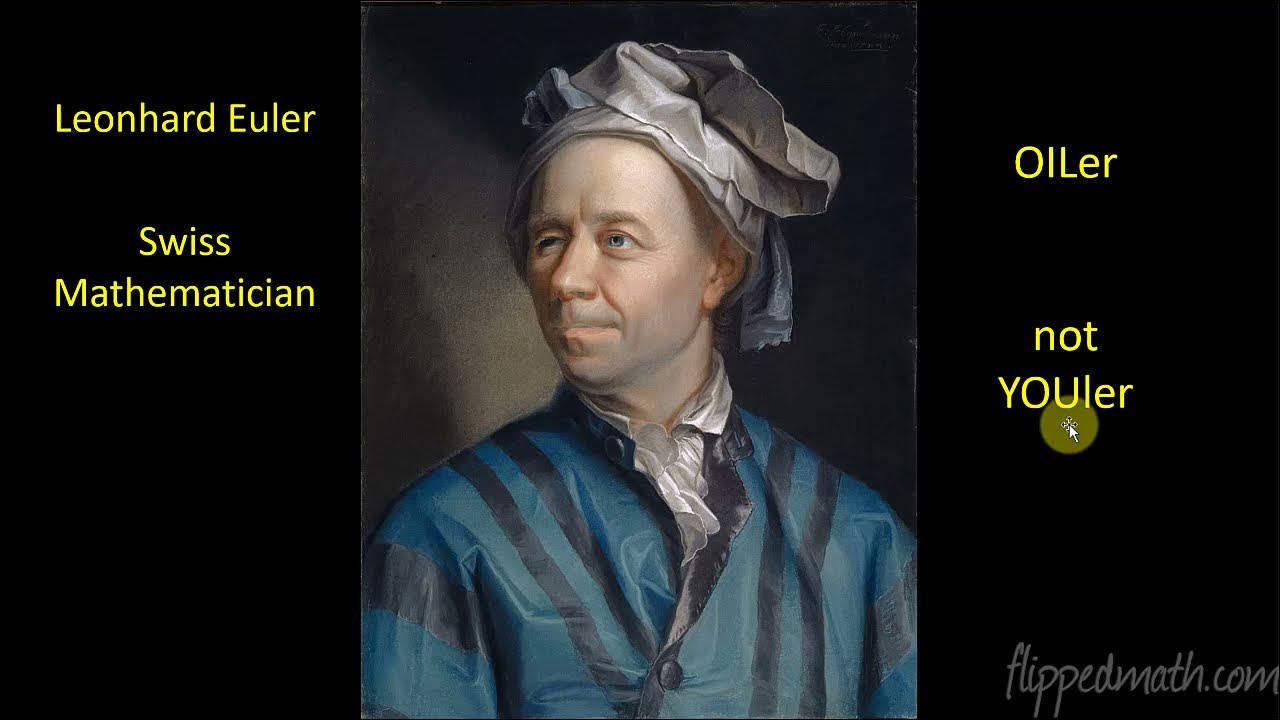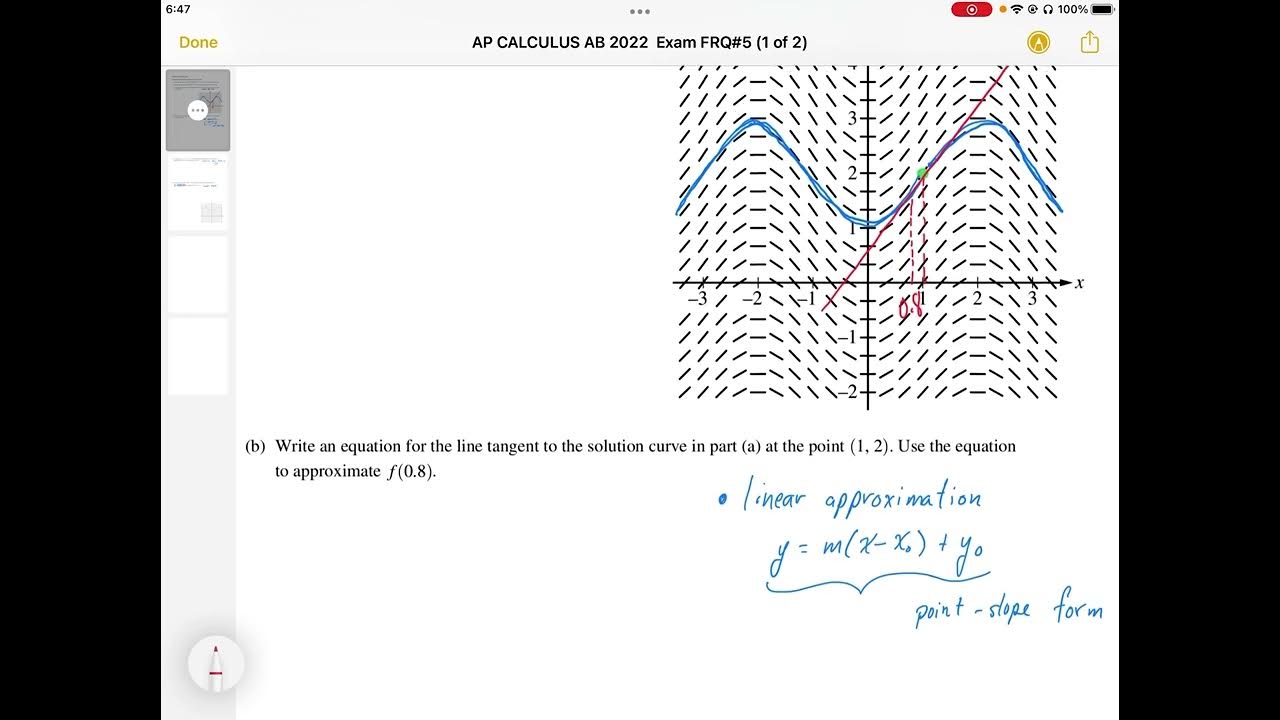2023 AP Calculus AB FRQ #6
TLDRThis video script is a detailed walkthrough of problem number six from the 2023 AP Calculus AB exam, focusing on implicit differentiation. The problem involves differentiating the equation 6xy = 2 + y^3 to find the derivative dy/dx, which is shown to be 2y/(y^2 - 2x). The video then explores two specific scenarios: finding a point on the curve where the tangent is horizontal (which is proven to be non-existent) and finding a point where the tangent is vertical, resulting in the coordinates (1/2, 1). Finally, the script addresses a particle moving along the curve, calculating the rate of change of the particle's vertical position (dy/dt) when at the point (1/2, -2) with a horizontal position increasing at a rate of 2/3 units per second. The solution to this part reveals dy/dt to be -8/9. The video is an excellent resource for those studying calculus, providing clear explanations and step-by-step solutions to complex problems.
Takeaways
- 🧮 The video discusses an implicit differentiation problem from the 2023 AP Calculus AB exam, specifically problem number six.
- 📐 The problem involves a curve defined by the equation 6xy = 2 + y^3 and requires finding the derivative dy/dx.
- 🔍 The derivative is found using the product rule and the chain rule, resulting in dy/dx = (2y)/(y^2 - 2x).
- 🚫 The video demonstrates that there are no points on the curve where the tangent line is horizontal, as y cannot be zero based on the given equation.
- ⚫ The video shows that there is a point on the curve where the tangent line is vertical, which occurs when y = 1 and x = 1/2.
- 🔢 For a particle moving along the curve, the rate of change of the horizontal position (dx/dt) is given as 2/3 units per second at the point (x, y) = (1/2, -2).
- 🆕 The problem requires finding dy/dt, the rate of change of the particle's vertical position, using the given information and the relationship between x, y, and time t.
- 🟡 The final calculated value for dy/dt at the specified instant is -8/9.
- 📝 The video emphasizes the importance of correctly applying differentiation rules and algebraic manipulation to solve calculus problems.
- 🤓 The presenter uses a step-by-step approach to guide viewers through the problem-solving process, which is helpful for understanding the concepts.
- 📚 The video serves as a comprehensive walkthrough of a specific AP Calculus AB exam problem, providing insights into the types of problems that may be encountered on the exam.
Q & A
What is the main topic of the video?
-The video is about solving an implicit differentiation problem from the 2023 AP Calculus AB exam.
What is the equation of the curve given in the problem?
-The equation of the curve is 6xy = 2 + y^3.
What is the derivative dy/dx that the video aims to find?
-The derivative dy/dx is found to be 2y / (y^2 - 2x).
What is the significance of finding the derivative in the problem?
-The derivative is needed for the other parts of the problem, so if part A is not solved, the rest of the problem cannot be completed.
How does the video approach finding the derivative?
-The video uses the product rule and the chain rule to differentiate both sides of the given equation and then rearranges to solve for dy/dx.
What does a horizontal tangent to the curve imply?
-A horizontal tangent implies that the derivative dy/dx is equal to zero.
What does the video conclude about the existence of a horizontal tangent?
-The video concludes that there are no points on the curve where the tangent is horizontal because setting dy/dx to zero leads to a contradiction (0 = 2).
What does a vertical tangent to the curve imply?
-A vertical tangent implies that the derivative dy/dx is undefined, which means the denominator in the derivative expression is zero.
How does the video find the point where the tangent is vertical?
-The video sets the denominator of the derivative to zero, solves for x in terms of y, and then substitutes this back into the original equation to solve for y, finding that y = 1 and x = 1/2.
What is the ordered pair at the point where the tangent is vertical?
-The ordered pair at the point where the tangent is vertical is (1/2, 1).
What is the problem presented in the final part of the video?
-The problem involves a particle moving along the curve, and it asks for the rate of change of the particle's vertical position (dy/dt) when the horizontal position is increasing at a rate of 2/3 units per second at the point (1/2, -2).
What is the value of dy/dt at the given instant?
-The value of dy/dt at the given instant is -8/9.
Outlines
📚 Implicit Differentiation Problem from AP Calculus Exam
This paragraph introduces an implicit differentiation problem from the 2023 AP Calculus AB exam. The problem involves the curve defined by the equation 6xy = 2 + y^3 and requires proving that the derivative dy/dx is equal to 2y/(y^2 - 2x). The presenter explains the process of differentiating both sides of the equation using the product rule and the chain rule, and then rearranges the terms to solve for dy/dx. The importance of this derivative is emphasized as it is needed for the subsequent parts of the problem. The paragraph concludes with the correct rearrangement of terms to match the required form of the derivative.
🔍 Identifying Points with Horizontal and Vertical Tangents
The second paragraph deals with finding specific points on the curve where the tangent line is either horizontal or vertical. For a horizontal tangent, the derivative dy/dx must be zero. The presenter substitutes this condition into the original curve equation and determines that there are no points on the curve where y equals zero, thus concluding that no horizontal tangents exist. For a vertical tangent, the derivative is undefined, which implies the denominator of the derivative expression is zero. This leads to solving for x in terms of y, and after substituting back into the original equation, it is found that there is a point where y=1 and x=1/2, indicating the existence of a vertical tangent at this point on the curve.
⏱ Calculating the Rate of Change for a Moving Particle
The final paragraph addresses a scenario where a particle is moving along the curve, and the rate of change of its horizontal position (dx/dt) is given at a specific point (x=1/2, y=-2). The task is to find the rate of change of the particle's vertical position (dy/dt) at that instant. The presenter uses the product rule to differentiate both sides of the original equation with respect to time (t), considering x and y as functions of time. By substituting the given values of x, y, and dx/dt, and solving for the unknown dy/dt, the presenter finds the rate of change of the particle's vertical position to be negative 8/9. This concludes the problem-solving process for the AP Calculus exam question.
Mindmap
Keywords
💡Implicit Differentiation
💡Product Rule
💡Chain Rule
💡Derivative
💡Horizontal Tangent
💡Vertical Tangent
💡Ordered Pair
💡Rate of Change
💡Differential Equation
💡AP Calculus AB
💡Tangent Line
Highlights
Solving an implicit differentiation problem from the 2023 AP Calculus AB exam.
Given curve equation: 6xy = 2 + y^3.
Derivative dy/dx is shown to be 2y / (y^2 - 2x).
Derivative dy/dx is crucial for solving other parts of the problem.
Using the product rule to differentiate both sides of the equation.
Applying the chain rule to the derivative of y^3.
Rearranging the equation to solve for dy/dx.
Finding horizontal tangent points by setting dy/dx to zero.
No horizontal tangent points exist since y cannot be zero.
Finding vertical tangent points by setting the denominator of dy/dx to zero.
Solving for x in terms of y to find vertical tangent points.
Only one vertical tangent point exists at (1/2, 1).
Particle moving along the curve with horizontal position increasing at a rate of dx/dt = 2/3 units per second.
Differentiating both sides of the equation with respect to time t.
Using the given point (1/2, -2) and dx/dt to solve for dy/dt.
Calculating dy/dt to be -8/9 for the given particle motion.
Complete solution of the entire AP Calculus AB problem.
Transcripts
Browse More Related Video

Implicit Differentiation | MIT 18.01SC Single Variable Calculus, Fall 2010

AP Calculus AB Crash Course Day 5 - Integration and Differential Equations

Calculus BC – 7.5 Approximating Solutions Using Euler’s Method

Implicit Differentiation | Differentiation when you only have an equation, not an explicit function

AP CALCULUS AB 2022 Exam Full Solution FRQ#5(a,b)

2004 AP Calculus AB Free Response #4
5.0 / 5 (0 votes)
Thanks for rating: